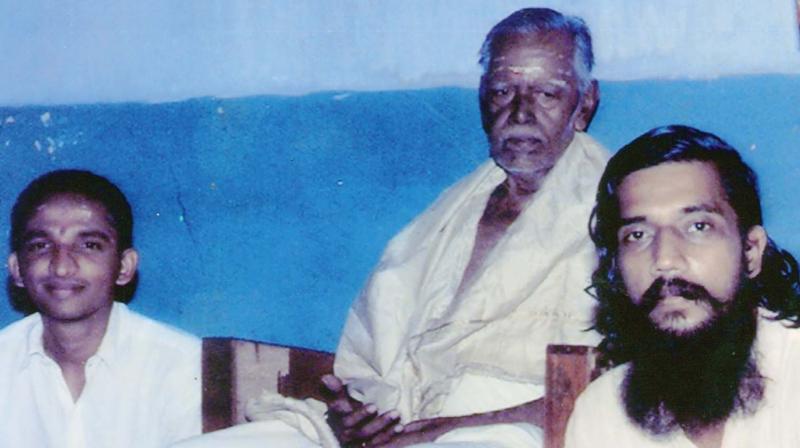Thiruvananthapuram: The strength of interpretative silence

Thiruvananthapuram: Silence as a form of subtle and sublime communication is what comes to mind whenever I think of V.K.Subrahmanya Sarma, who brought back tradition to the quaint Tamil Brahmin settlement at Karamana, with his free Veda classes in the late Sixties.
Adored just as Japa Sir, he spurned both name and fame. Very few of us kids who attended his classes knew even his name those days. Shunning the limelight, he gave of his knowledge to the young, as if it was worship.
He came across as the anti-thesis of the Goldsmithian village school master of whom I learned in my regular school except for the fact that: “Still they gazed and still the wonder grew; that one small head could carry all he knew”.
If the entire length of the Vedic mantras, Upanishads, Sanskrit sacred slokas and bhajans that he taught from memory were to be recorded, it would have run into a minimum of 12 hours on the trot. The range of his teaching was from simple daily prayers and slokas to passages from the Vedas and readings from the Valmiki Ramayana.
Unfailingly, as dusk fell, he would be there at the local Sathyavageeswara temple to begin his Veda recitation classes and compositions of the likes of Kalidasa, Vedanta Desika, Sadashiva Brahmendra and Shankaracharya. He had successfully experimented with the format of such classes in the 1940s near Nagercoil and later at Ernakulum.
No text books, no copies, no pen or pencil, no nothing. You have to hear and repeat after him. In the words of the great Indologist, Monier Williams “Sruti is that which has been only heard and verbally transmitted from generation to generation”. And Sarma was just part of “Sruti”, passing down his knowledge through word of mouth.
Beside him and in front, tiny tots would sit and recant in binary chants, small broken-down parts of the Vedas, the multi-layered meanings of which would have been alien to them at that time. The classes would be over in about 30 minutes but over a period of more than 10 years most of these boys would have learnt by rote over 400/500 pages of text
Geniality personified, he barely uttered a word, aside from what he chanted. His benign face would bear a half-smile. And if there was an occasional word with a student that was a bonus. In Indian legend, the theory of “interpretative silence” (Mouna Vyakhyana) is one with great implosive power. Metaphorically, it is stated that the teacher’s interpretative silence dashes all the doubts of his students.
For me, V.K. Subrahmanya Sarma’s greatest quality was this sound of silence. He never ordained anything to be done in any particular way. I never heard him dwell on any rituals. His was a style of accommodative, inclusive, diverse and decentralised teaching which left scope for his students to pick up the threads as they wanted.
I had the good fortune to learn also Sanskrit from him at his house. There too he was never didactic. When I look back, the best takeaway for me was this freedom of choice which he gave akin to what the Gita also concludes: “Use your intellect, ponder over these teachings deeply and do as you deem fit”.
For me, the crux of the mantras that he taught but never attempted to explain, now evoke meanings which find resonance with my non-orthodox and non-ritualistic worldview. I believe he consciously decided to let students “experience” the import of the mantras as they evolve rather than mould them into a particular school of thought.
Recalls his Mumbai-based Chartered Accountant son, S. Natarajan: “My father did not believe in imposing his views on anyone. There was no pressure on us, his children, to learn the Vedas. He believed in leading and guiding by example. And that has been his style right from the time he took up teaching as a profession.”
He started the classes in 1969 with just nine students and over time scores studied under him. Says Dr Sahasranamam, leading ophthalmologist and Director of the Regional Institute of Ophthalmology, Thiruvananthapuram, one of his first students: “Verily, what I imbibed from him was a way of life which stands me in good stead even today”
Adds H. Ganesh, president of the Karamana Grama Samudayam: “His perseverance was admirable. We all yielded to his consistency and steadfastness. He was self-effacing to a fault. In fact, the name Vaidika Dharma Sabha (VDS) was incidentally adopted for these kinds of initiatives only in 1978”
In 1978, he left for Mumbai to stay with his eldest son who was teaching at the IIT there and started classes there too. The mantle then fell on his leading disciple Sekhar (H. Parameswaran) who has been running the classes, under the auspices of VDS, for the last 40 years. He retired as Dy Chief Engineer from the Kerala PWD. Hundreds of his students are settled all over the world from Sydney to New York. Sekhar has taught two generations including women and he himself has learnt Yajur Veda samhitas fully.
VDS is celebrating 50 years of an unbroken attempt, started by ”Japa Sir” to keep tradition alive. Gomathy Mahadevan, a top executive who retired from Tech Mahindra and S. Padmanabha Iyer (ex-Uco Bank) have big plans: “We have a yearlong schedule with daily evening prayers at individual houses, spoken Sanskrit classes and mass connect programmes leading to a grand finale by Vijayadashami, 2019. We want to turn Karamana into Kerala’s first Sanskrit-speaking village”.
Japa Sir’s influence has been like “the gentle morning dew which falls unseen and unheard and yet brings into blossom the fairest of roses”. Into its 50th year, Vaidika Dharma Sabha will do well to reach out, engage with all who are interested in the study and propagation of the Vedic knowledge and continue its quiet character-building work.

